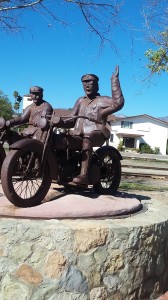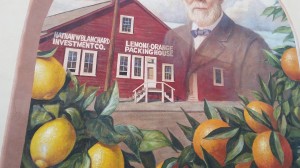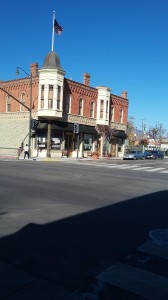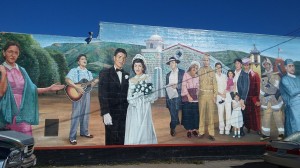THE CITRUS CAPITAL OF THE WORLD
THE CITRUS CAPITAL OF THE WORLD
By Charles N. Stevens
Photos by Dolores Seidman
We began our tour on foot near the old Santa Paula railroad station, once a stop on the Southern Pacific coast line. Today, the Fillmore & Western Railway uses the 1887 depot for the terminus of its tourist train that originates in Fillmore. It also houses the local art museum.
Directly across the street from the railroad station is a most unusual memorial. It is a statue of sorts of two policemen on motorcycles. It memorializes an event that took place at midnighton March 12, 1925, the sudden collapse of the St. Francis Dam in San Francisquito Canyon. The abrupt release caused a 120 foot wall of water to pour into the Santa Clara River bed menacing all the cities along it, including Santa Paula. Two motorcycle policemen racing ahead of the flood, sirens wailing, warned countless sleeping people of the impending disaster, thereby saving lives. 431 people were swept away by the flood, making it the worst California disaster since the San Francisco earthquake.
We continue our walk towards Main Street, only a block away. We plan to casually look at the town, especially the large murals that have been painted throughout the downtown area. At the corner of Main and 10th Street stands a most unusual building with an old fashioned cupola extending from one of its corners. It was once the headquarters of the Union Oil Company and dates from 1890 when Santa Paula was a center of the petroleum industry. Today the building is an oil museum.
At this same intersection is a large mural celebrating Santa Paula’s Latino culture. As we stroll through the village-like atmosphere of the town, we note the Latino influence in the many Mexican restaurants and shops. Keeping a lookout for more murals, we spot another one in the next block as we walk west. It is a mural depicting the way Santa Paula looked in 1910, far different from the town of today. The most spectacular mural is a gigantic one advertising Santa Paula as the Citrus Capital of the World. We had seen another mural near the railroad station celebrating Santa Paula’s artists and architects, but it was partially shaded by a gigantic Moreton fig tree.
Sana Paula is a lovely town set in the middle of orange and lemon groves and acres of avocados with hills on both sides, a kind of paradise. Outside of town are many fruit stands selling citrus and other products fresh from the trees. I have visited Santa Paula many times and have always felt that it was special place. I liked it especially when the packing houses were in full operation and iced refrigerator cars were lined up by them to be loaded. Long trains of yellow refrigerator cars left the valley every day. Today, trucks haul it all and the spurs leading to the packing houses rust or are torn up.
There are several places of note in the town that we did not visit on this trip, but we have seen them before. One is the famous Glen Tavern Inn and Restaurant built in 1911 during Santa Paula’s oil boom. They have well-appointed rooms, a wonderful lounge and an Italian restaurant. It is worth a visit to the lounge, to walk through its elegance or sit for a while. other highlights of the town are the art museum and the agricultural museum where agricultural implements new and old are on display.

The statue is a memorial to the two policemen who warned people about the approaching flood in the middle of the night in l925.

This is a mural depicting Santa Paula as the citrus capitol of the world.

The former headquarters of the Union Oil Company is now an oil museum.

The mural depicts Latino life in Santa Paula and the Santa Clara River Valley.
MONTEREY PARK AUTHOR PUBLISHES 4th BOOK – Seeking More of the Sky: Growing Up in the 1930’s:
Charles “Norm” Stevens, a 43 year resident of Monterey Park has recently published his 4th book: Seeking More of the Sky: Growing Up in the 1930’s. This is the story of a young boy growing up in Inglewood, California in the l930’s. This was a time during the depression when unemployment was affecting many and the banks were closed, while the clouds of war were gathering in Europe. But he was lucky enough to be raised in a loving family, the power of that love reflected throughout his stories.
Stevens is the author of three previous books about his experiences during WWII:
An Innocent at Polebrook: A Memoir of an 8th Air Force Bombardier (Story of his 34 bombing missions from his base at Polebrook, England over Germany and France)
The Innocent Cadet: Becoming A World War II Bombardier (A prequel to the first, telling of his training in the U.S. before going overseas into combat.)
Back from Combat: A WWII Bombardier Faces His Military Future from Combat: (This book details the time from when he returned from combat in England until the end of the war.)
He is known to the readers of The Citizen’s Voice as the author of Travel Log Articles including “Cruising the Rhine and Mosel”,” Best of the West”, “In Search of Snow” , “From Paris to Normandy on the Seine”, and “Exploring New York”. He is retired, having taught for 32 years, primarily in the Montebello Unified School District.
Those interested in purchasing an autographed copy of any of his books, may contact the author at 323-721-8230 or Normstevens24@gmail.com.



